The global enterprise data observability software market is valued at USD 1.5 billion in 2025. It is slated to reach USD 3.6 billion by 2035, recording an absolute increase of USD 2 billion over the forecast period. This translates into a total growth of 130.3%, with the market forecast to expand at a compound annual growth rate (CAGR) of 8.7% between 2025 and 2035. The overall market size is expected to grow by nearly 2.30X during the same period, supported by increasing demand for data quality assurance and pipeline monitoring, growing adoption of cloud-based data infrastructure and analytics platforms, and rising emphasis on data reliability and governance across diverse enterprise data operations, machine learning workflows, and business intelligence applications.
Between 2025 and 2030, the enterprise data observability software market is projected to expand from USD 1.5 billion to USD 2.3 billion, resulting in a value increase of USD 799.3 million, which represents 39.7% of the total forecast growth for the decade. This phase of development will be shaped by increasing complexity of modern data architectures and multi-cloud environments, rising adoption of real-time data analytics requiring continuous monitoring, and growing demand for automated data quality detection in enterprise data warehouses and data lakes. Technology companies and data-driven organizations are expanding their data observability capabilities to address the growing demand for proactive data issue detection solutions that ensure data pipeline reliability and analytics accuracy.
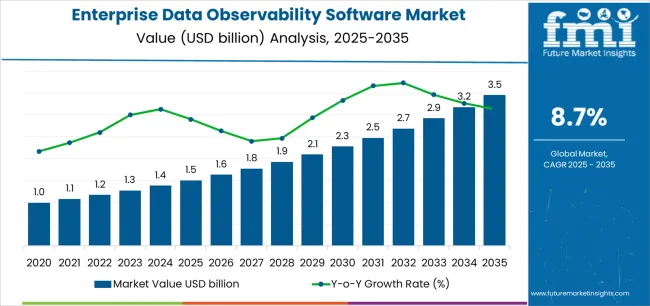
From 2030 to 2035, the market is forecast to grow from USD 2.3 billion to USD 3.6 billion, adding another USD 1.2 billion, which constitutes 60.3% of the overall ten-year expansion. This period is expected to be characterized by the expansion of artificial intelligence and machine learning applications requiring high-quality training data, the development of advanced anomaly detection algorithms leveraging machine learning capabilities, and the growth of specialized implementations for real-time streaming data monitoring and data mesh architectures. The growing adoption of DataOps practices and automated data governance frameworks will drive demand for enterprise data observability software with enhanced intelligence and comprehensive monitoring coverage.
Between 2020 and 2025, the enterprise data observability software market experienced steady growth, driven by increasing recognition of data quality challenges and growing awareness of data observability platforms as essential tools for maintaining data pipeline health and preventing downstream analytics issues in diverse enterprise data environments and cloud data platforms. The market developed as data engineers and analytics leaders recognized the potential for data observability technology to reduce data downtime, improve data trustworthiness, and support comprehensive data quality management while meeting business-critical analytics requirements. Technological advancement in metadata collection and lineage tracking began emphasizing the critical importance of maintaining end-to-end visibility and proactive issue detection in complex data ecosystems.
| Metric | Value |
|---|---|
| Estimated Value in (2025E) | USD 1.5 billion |
| Forecast Value in (2035F) | USD 3.6 billion |
| Forecast CAGR (2025 to 2035) | 8.7% |
Market expansion is being supported by the increasing global complexity of enterprise data architectures driven by cloud migration and modern data stack adoption, alongside the corresponding need for comprehensive monitoring solutions that can detect data quality issues, prevent pipeline failures, and maintain analytics reliability across various cloud data platforms, real-time streaming systems, and distributed data processing applications. Modern data engineering teams and analytics organizations are increasingly focused on implementing data observability solutions that can provide proactive anomaly detection, deliver automated incident alerting, and ensure consistent data quality in demanding production environments.
The growing emphasis on data-driven decision making and analytics trustworthiness is driving demand for enterprise data observability software that can support automated data quality monitoring, enable rapid incident resolution, and ensure comprehensive visibility across complex data pipelines. Technology organizations' preference for observability platforms that combine automated anomaly detection with root cause analysis capabilities and operational efficiency is creating opportunities for innovative data observability implementations. The rising influence of artificial intelligence applications and machine learning model deployment is also contributing to increased adoption of data observability software that can provide superior data quality assurance without compromising pipeline performance or development velocity.
The market is segmented by deployment type, application, and region. By deployment type, the market is divided into cloud based and on-premises. Based on application, the market is categorized into large enterprises and SMEs. Regionally, the market is divided into East Asia, Europe, North America, South Asia, Latin America, Middle East & Africa, and Eastern Europe.
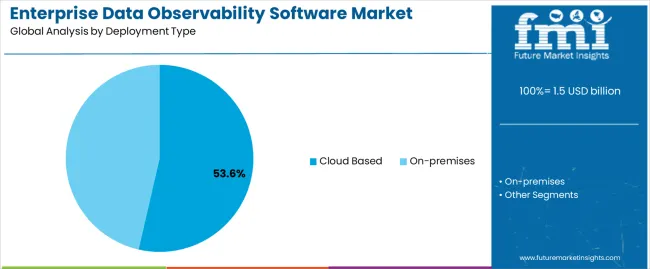
The cloud based segment is projected to maintain its leading position in the enterprise data observability software market in 2025 with a 53.6% market share, reaffirming its role as the preferred deployment model for modern data observability implementations and cloud-native data platform monitoring. Data engineering teams and platform architects increasingly utilize cloud-based data observability software for its rapid deployment capabilities, seamless integration with cloud data platforms, and proven effectiveness in monitoring distributed data systems while maintaining scalability and operational flexibility. Cloud based deployment technology's proven effectiveness and implementation versatility directly address the industry requirements for agile data quality monitoring and comprehensive observability coverage across diverse cloud data warehouses and data lake environments.
This deployment segment forms the foundation of modern data observability strategies, as it represents the approach with the greatest contribution to deployment velocity and established integration capabilities across multiple cloud platforms and data processing frameworks. Technology industry investments in cloud-native data infrastructure continue to strengthen adoption among data teams and platform operators. With architectural trends requiring elastic observability scaling and improved monitoring coverage, cloud-based enterprise data observability software aligns with both operational agility objectives and cost efficiency requirements, making it the central component of comprehensive data reliability strategies.
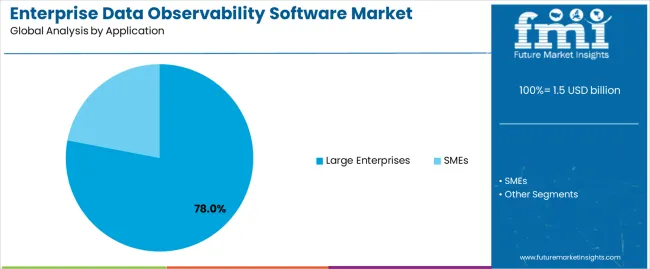
The large enterprises application segment is projected to represent the largest share of enterprise data observability software demand in 2025 with a 78% market share, underscoring its critical role as the primary driver for platform adoption across Fortune 500 companies, global technology firms, and established corporations operating complex data ecosystems. Large enterprise organizations prefer data observability software due to its ability to monitor extensive data infrastructure, detect quality issues across numerous data pipelines, and support enterprise-scale data operations while enabling centralized monitoring and governance capabilities. Positioned as essential platforms for modern enterprise data management, data observability software offers both operational risk mitigation and analytics reliability assurance.
The segment is supported by continuous expansion in enterprise data volumes and the growing complexity of data architectures that necessitate sophisticated monitoring capabilities with enhanced anomaly detection and comprehensive lineage tracking. Additionally, large enterprises are investing in data observability platforms to support increasingly critical data-driven operations and organizational demands for trusted analytics powering business decisions across multiple functions and regions. As data infrastructure complexity increases and analytics dependence grows, the large enterprises application will continue to dominate the market while supporting advanced observability adoption and data quality optimization strategies.
The enterprise data observability software market is advancing steadily due to increasing complexity of modern data architectures driven by cloud migration and microservices adoption and growing implementation of data quality requirements that necessitate platforms providing automated anomaly detection and proactive monitoring capabilities across diverse cloud data warehouses, streaming data platforms, and machine learning pipelines. However, the market faces challenges, including integration complexity with legacy data systems and diverse technology stacks, skills gaps related to data observability implementation and interpretation, and competition from traditional data quality tools and application performance monitoring solutions. Innovation in machine learning-based anomaly detection and automated root cause analysis continues to influence product development and market expansion patterns.
The growing migration to cloud data platforms is driving demand for observability solutions that address unique monitoring challenges including distributed data processing, multi-cloud data movement, and real-time streaming analytics requiring continuous quality verification. Modern data stack implementations require sophisticated data observability software that delivers comprehensive monitoring across diverse data technologies while supporting agile development practices and operational efficiency objectives. Data platform teams are increasingly recognizing the operational advantages of data observability integration for preventing data incidents and maintaining analytics reliability, creating opportunities for cloud-native monitoring platforms specifically designed for Snowflake, Databricks, BigQuery, and other modern data warehouse environments.
Modern enterprise data observability software providers are incorporating artificial intelligence algorithms and machine learning models to enhance anomaly detection accuracy, reduce false positive alerts, and support comprehensive data quality management through intelligent pattern recognition and predictive issue detection. Leading companies are developing platforms with automated threshold learning, implementing behavior-based anomaly detection, and advancing root cause analysis capabilities that provide actionable insights and resolution guidance. These technologies improve operational efficiency while enabling new capabilities, including predictive data quality forecasting, automated incident classification, and intelligent alert routing. Advanced AI integration also allows data teams to support comprehensive data reliability objectives and operational excellence beyond traditional rule-based monitoring approaches.
The expansion of complex data transformation workflows and increasing need for understanding data dependencies is driving development of advanced data lineage tracking and downstream impact analysis capabilities within observability platforms. These advanced applications require comprehensive metadata collection and sophisticated graph analysis technologies that enable visualization of data flows and assessment of issue impacts, creating premium market segments with differentiated value propositions. Providers are investing in metadata extraction technologies and lineage visualization systems to serve organizations requiring detailed dependency understanding while supporting innovation in data governance, compliance reporting, and change impact assessment capabilities.
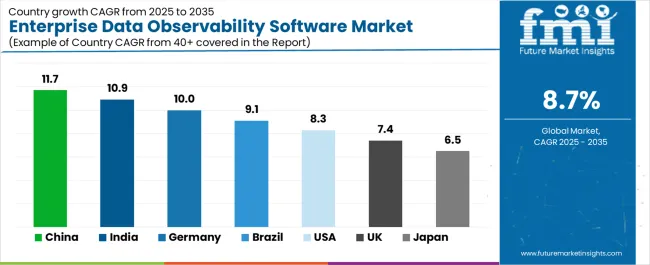
| Country | CAGR (2025-2035) |
|---|---|
| China | 11.7% |
| India | 10.9% |
| Germany | 10% |
| Brazil | 9.1% |
| United States | 8.3% |
| United Kingdom | 7.4% |
| Japan | 6.5% |
The enterprise data observability software market is experiencing solid growth globally, with China leading at a 11.7% CAGR through 2035, driven by rapid digital transformation, expanding cloud infrastructure adoption, and increasing emphasis on data-driven business operations across technology companies and financial services. India follows at 10.9%, supported by growing technology sector, expanding data analytics adoption, and increasing investments in cloud-based data platforms among enterprises and digital-native companies. Germany shows growth at 10%, emphasizing data governance requirements, manufacturing sector digitalization, and strong enterprise software adoption supporting advanced data management practices. Brazil demonstrates 9.1% growth, supported by digital banking expansion, e-commerce growth, and increasing cloud adoption requiring data quality assurance capabilities. The United States records 8.3%, focusing on mature data infrastructure, extensive cloud data platform adoption, and established DataOps practices among technology companies and data-driven enterprises. The United Kingdom exhibits 7.4% growth, emphasizing financial services technology advancement, cloud migration initiatives, and data governance regulatory requirements. Japan shows 6.5% growth, supported by enterprise digital transformation, manufacturing sector data initiatives, and quality-focused data management practices.
The report covers an in-depth analysis of 40+ countries, top-performing countries are highlighted below.
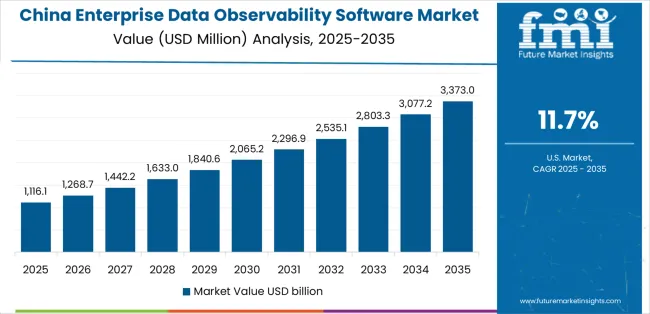
Revenue from enterprise data observability software in China is projected to exhibit exceptional growth with a CAGR of 11.7% through 2035, driven by massive digital transformation initiatives and rapidly expanding cloud infrastructure adoption supported by government digitalization policies and technology sector innovation programs. The country's large technology sector and increasing investment in data analytics capabilities are creating substantial demand for data observability solutions. Major cloud platform providers and enterprise software companies are establishing comprehensive data observability offerings to serve both domestic technology companies and multinational enterprises.
Revenue from enterprise data observability software in India is expanding at a CAGR of 10.9%, supported by the country's rapidly growing technology sector, expanding data analytics adoption, and increasing cloud platform implementation among enterprises and digital-native organizations. The country's comprehensive software development capabilities and rising data maturity are driving sophisticated data observability adoption throughout diverse industry sectors. Leading technology companies and cloud service providers are establishing data observability product offerings and implementation services to address growing market demand.
Revenue from enterprise data observability software in Germany is expanding at a CAGR of 10%, supported by the country's strong data governance requirements, manufacturing sector digitalization initiatives, and comprehensive enterprise software adoption supporting advanced data management practices. The nation's technological capabilities and quality emphasis are driving sophisticated data observability implementations throughout industrial and enterprise sectors. Leading enterprise software companies and consulting firms are investing extensively in data observability platform integration and implementation expertise.
Revenue from enterprise data observability software in Brazil is expanding at a CAGR of 9.1%, supported by the country's expanding digital banking sector, growing e-commerce platforms, and increasing cloud adoption requiring data quality assurance capabilities. Brazil's digital economy growth and improving technology infrastructure are driving demand for data observability solutions. Technology vendors and system integrators are investing in market development to serve both financial services and digital commerce sectors.
Revenue from enterprise data observability software in the United States is expanding at a CAGR of 8.3%, supported by the country's mature data infrastructure, extensive cloud data platform adoption, and established DataOps practices among technology companies and data-driven enterprises. The nation's technology leadership and data-centric business models are driving demand for advanced data observability platforms. Software vendors and platform providers are investing in product innovation and market expansion to serve diverse enterprise requirements.
Revenue from enterprise data observability software in the United Kingdom is expanding at a CAGR of 7.4%, supported by the country's financial services technology advancement, cloud migration initiatives, and data governance regulatory requirements driving data quality monitoring adoption. The UK's financial sector sophistication and technology innovation are driving demand for data observability solutions. Software vendors and consulting firms are establishing data observability implementation practices and technical expertise.
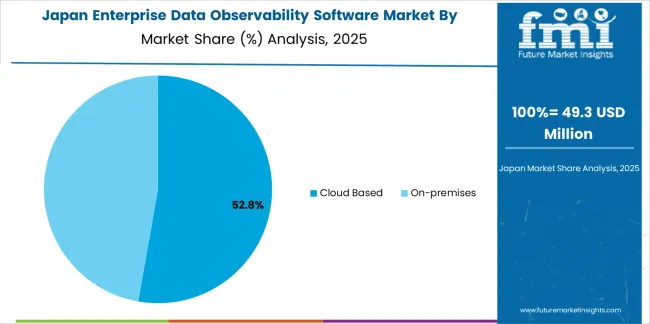
Revenue from enterprise data observability software in Japan is expanding at a CAGR of 6.5%, supported by the country's enterprise digital transformation initiatives, manufacturing sector data programs, and quality-focused data management practices among established corporations. Japan's technological sophistication and operational excellence culture are driving demand for reliable data observability platforms. Software providers and system integrators are investing in product localization and implementation expertise for Japanese enterprise requirements.

The enterprise data observability software market in Europe is projected to grow from USD 531.3 million in 2025 to USD 1.2 billion by 2035, registering a CAGR of 8.6% over the forecast period. Germany is expected to maintain leadership with a 27.8% market share in 2025, moderating to 27.5% by 2035, supported by strong enterprise software adoption, manufacturing sector digitalization, and comprehensive data governance frameworks.
France follows with 19.5% in 2025, projected at 19.7% by 2035, driven by financial services technology, cloud migration initiatives, and data governance regulatory compliance. The United Kingdom holds 17.3% in 2025, reaching 17% by 2035 on the back of financial services technology advancement and digital transformation programs. Italy commands 13.2% in 2025, rising slightly to 13.4% by 2035, while Spain accounts for 10.1% in 2025, reaching 10.3% by 2035 aided by digital banking growth and enterprise cloud adoption. The Netherlands maintains 5.6% in 2025, up to 5.7% by 2035 due to technology sector concentration and data-driven business practices. The Rest of Europe region, including Nordics, Central & Eastern Europe, and other markets, is anticipated to hold 6.5% in 2025 and 6.4% by 2035, reflecting steady development in enterprise data infrastructure, cloud platform adoption, and data quality monitoring implementation.
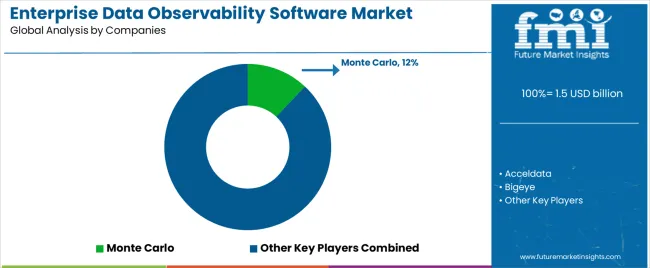
The enterprise data observability software market is characterized by competition among specialized data observability startups, established enterprise software companies, and cloud platform providers. Companies are investing in machine learning algorithm development, platform integration capabilities, user experience enhancement, and customer success programs to deliver intelligent, comprehensive, and actionable data observability solutions. Innovation in automated anomaly detection, data lineage visualization, and incident management workflows is central to strengthening market position and competitive advantage.
Monte Carlo leads the market with comprehensive data observability platform focusing on automated anomaly detection, data lineage tracking, and incident management across cloud data warehouses and data lakes. Acceldata provides multi-layered data observability solutions with emphasis on performance monitoring and data reliability assurance. Bigeye offers user-friendly data quality monitoring with focus on automated anomaly detection and SQL-based metric definition. Soda.io delivers data quality testing and monitoring with emphasis on data contract verification and collaborative workflows. IBM provides enterprise-grade data quality and observability capabilities integrated with comprehensive data management platforms. Great Expectations specializes in open-source data validation and documentation frameworks.
Additional market participants include Cribl, Lightup, Informatica, Cisco, AWS, Datadog, Dynatrace, Elastic, New Relic, Splunk, StackState, Pantomath, Telmai, Apica, Greptime, Integrate.io, Metaplane, Precisely, Sifflet, and Synq, each contributing specialized expertise in data monitoring technologies, integration capabilities, and industry-specific solutions.
Enterprise data observability software represents a rapidly growing data infrastructure category within enterprise technology and analytics platforms, projected to grow from USD 1.5 billion in 2025 to USD 3.6 billion by 2035 at a 8.7% CAGR. These specialized monitoring platforms, providing comprehensive visibility into data pipeline health and quality issues, serve as critical infrastructure for data engineering teams, analytics organizations, and data-driven enterprises where data reliability, pipeline monitoring, and analytics trustworthiness are paramount. Market expansion is driven by increasing data architecture complexity, growing cloud data platform adoption, expanding machine learning applications, and rising demand for proactive data quality management across diverse technology companies, financial services firms, and enterprise organizations.
| Items | Values |
|---|---|
| Quantitative Units (2025) | USD 1.5 billion |
| Deployment Type | Cloud Based, On-premises |
| Application | Large Enterprises, SMEs |
| Regions Covered | East Asia, Europe, North America, South Asia, Latin America, Middle East & Africa, Eastern Europe |
| Countries Covered | China, India, Germany, Brazil, United States, United Kingdom, Japan, and 40+ countries |
| Key Companies Profiled | Monte Carlo, Acceldata, Bigeye, Soda.io, IBM, Great Expectations |
| Additional Attributes | Dollar sales by deployment type and application category, regional demand trends, competitive landscape, technological advancements in machine learning-based anomaly detection, data lineage tracking, automated root cause analysis, and data quality monitoring automation |
The global enterprise data observability software market is estimated to be valued at USD 1.5 billion in 2025.
The market size for the enterprise data observability software market is projected to reach USD 3.5 billion by 2035.
The enterprise data observability software market is expected to grow at a 8.7% CAGR between 2025 and 2035.
The key product types in enterprise data observability software market are cloud based and on-premises.
In terms of application, large enterprises segment to command 78.0% share in the enterprise data observability software market in 2025.






Our Research Products

The "Full Research Suite" delivers actionable market intel, deep dives on markets or technologies, so clients act faster, cut risk, and unlock growth.

The Leaderboard benchmarks and ranks top vendors, classifying them as Established Leaders, Leading Challengers, or Disruptors & Challengers.

Locates where complements amplify value and substitutes erode it, forecasting net impact by horizon

We deliver granular, decision-grade intel: market sizing, 5-year forecasts, pricing, adoption, usage, revenue, and operational KPIs—plus competitor tracking, regulation, and value chains—across 60 countries broadly.

Spot the shifts before they hit your P&L. We track inflection points, adoption curves, pricing moves, and ecosystem plays to show where demand is heading, why it is changing, and what to do next across high-growth markets and disruptive tech

Real-time reads of user behavior. We track shifting priorities, perceptions of today’s and next-gen services, and provider experience, then pace how fast tech moves from trial to adoption, blending buyer, consumer, and channel inputs with social signals (#WhySwitch, #UX).

Partner with our analyst team to build a custom report designed around your business priorities. From analysing market trends to assessing competitors or crafting bespoke datasets, we tailor insights to your needs.
Supplier Intelligence
Discovery & Profiling
Capacity & Footprint
Performance & Risk
Compliance & Governance
Commercial Readiness
Who Supplies Whom
Scorecards & Shortlists
Playbooks & Docs
Category Intelligence
Definition & Scope
Demand & Use Cases
Cost Drivers
Market Structure
Supply Chain Map
Trade & Policy
Operating Norms
Deliverables
Buyer Intelligence
Account Basics
Spend & Scope
Procurement Model
Vendor Requirements
Terms & Policies
Entry Strategy
Pain Points & Triggers
Outputs
Pricing Analysis
Benchmarks
Trends
Should-Cost
Indexation
Landed Cost
Commercial Terms
Deliverables
Brand Analysis
Positioning & Value Prop
Share & Presence
Customer Evidence
Go-to-Market
Digital & Reputation
Compliance & Trust
KPIs & Gaps
Outputs
Full Research Suite comprises of:
Market outlook & trends analysis
Interviews & case studies
Strategic recommendations
Vendor profiles & capabilities analysis
5-year forecasts
8 regions and 60+ country-level data splits
Market segment data splits
12 months of continuous data updates
DELIVERED AS:
PDF EXCEL ONLINE
Enterprise Web Development Outsourcing Services Market Size and Share Forecast Outlook 2025 to 2035
Enterprise Asset Management Market Size and Share Forecast Outlook 2025 to 2035
Enterprise A2P SMS Market Size and Share Forecast Outlook 2025 to 2035
Enterprise-Class Hybrid Storage Market Size and Share Forecast Outlook 2025 to 2035
Enterprise Feedback Management Market Size and Share Forecast Outlook 2025 to 2035
Enterprise Social Graph Market Size and Share Forecast Outlook 2025 to 2035
Enterprise File Sync And Share Platform Market Size and Share Forecast Outlook 2025 to 2035
Enterprise Mobility Market Size and Share Forecast Outlook 2025 to 2035
Enterprise Rights Management Solution Market Size and Share Forecast Outlook 2025 to 2035
Enterprise LLM Market Size and Share Forecast Outlook 2025 to 2035
Enterprise VSAT Systems Market Size and Share Forecast Outlook 2025 to 2035
Enterprise AI Governance and Compliance Market Analysis - Size, Share, and Forecast Outlook 2025 to 2035
Enterprise Feedback Management Industry Analysis in Western Europe Size and Share Forecast Outlook 2025 to 2035
Enterprise Feedback Management Industry Analysis in Korea Size and Share Forecast Outlook 2025 to 2035
Enterprise Feedback Management Industry Analysis in Japan Size and Share Forecast Outlook 2025 to 2035
Enterprise Content Management Market Size and Share Forecast Outlook 2025 to 2035
Enterprise IoT Market Size and Share Forecast Outlook 2025 to 2035
Enterprise WLAN Market Size and Share Forecast Outlook 2025 to 2035
Enterprise Network Equipment Market Size and Share Forecast Outlook 2025 to 2035
Enterprise Social Networks Market Size and Share Forecast Outlook 2025 to 2035

Thank you!
You will receive an email from our Business Development Manager. Please be sure to check your SPAM/JUNK folder too.
Chat With
MaRIA